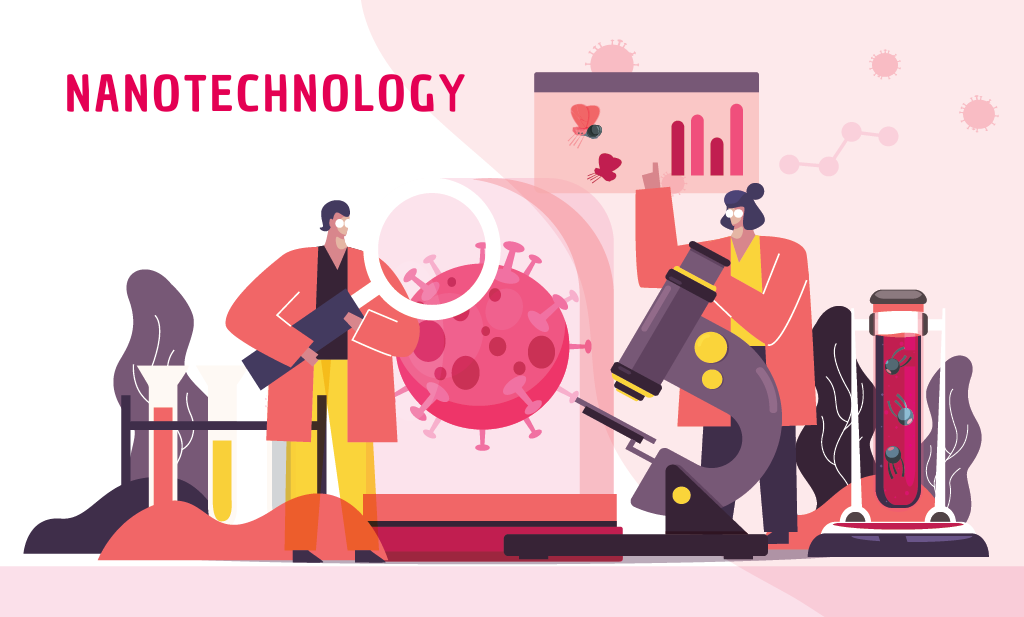Nanotechnology

Imagine, you were blessed with some super-powers one day by which you shrunk yourself around 1500 million times! Now if you notice the things around you, they will not be like the normal things that you usually encounter, but you will be able to observe the atoms and molecules which are the fundamental elements for everything! If you zoom into the “nanoscale,” you will not only see the atoms that everything is made from but also you will be able to work out with them! Fabricating and developing new things at the “nanoscale” level is what we call Nanotechnology. It is the fastest- growing subject nowadays!
How big is Nano ?
We usually encounter a scale of meters and kilometres (thousands of meters), so now, the question arises “How do we deal with the microscopic-world ?!”, You might have seen extraordinary photos of cells and its components in science books which were taken from instruments known as microscopes. These powerful scientific instruments make us visualize the microscopic elements. Nanoscopic involves zooming in things down to a whole new level. Nano means “billionth”, so by nanometre we mean it is one-billionth of a meter. In other words, the nanoscale is 1000 times smaller than the microscopic scale and it is billion (1000 million) times smaller than the world of meters that we usually face.


From Nanoscience to Nanotechnology
This is all very worth-noting and quite impressive, but how one can use it? and what are it’s usage? Our lives get its meaning from a scale of meters, but it becomes difficult to think about ordinary, everyday existence on the “nanoscale”. This is the microscopic world where the atoms, molecules (atoms joined together) and cells play a very important role! It is a place where science and technology display another side of the coin.

By zooming into the nanoscale, we explore the basic building blocks (i.e. atoms and molecules) of a material and their behaviour. You all have seen the plants and appreciated their need in nature, but what is inside it? If you zoom in a little bit you will realize that these plants consist of cells. Now if you keep zooming in, you will find that these cells are comprised of atoms and molecules which reflects their behaviour. So, with the above example, you might have guessed how important is this concept of nanoscience for us to understand. It opens a completely new realm for further research and development called, Nanotechnology. That’s what the correct definition of the word “technology” and its how the technology differs from science, which is about studying things for their own sake.

What’s so good about Nanoscale ?
It turns out that, there is a lot of interesting stuff about particles in the world of the nanoscale. Lots of substances exhibit different behaviours in the world comprised of atoms and molecules. Materials can show contrasting physical properties on the nanoscale even if they’re still the same materials! Through the perspective of nanoscale, atoms and molecules can move freely around and between one another, so this results in making chemical properties of materials to be contrasting. When exposed to other nanoparticles, nanoparticles have much more surface area, so they act as very good catalysts (substances that speed up chemical reactions).

Application of Nanotechnology
In our day to day world, gravity is the most significant force that we encounter: it dominates everything around us, from the way we stay at the ground instead of flying off the surface to the way Earth has a stable atmosphere. But on the nanoscale, gravity loses its significance in front of the electromagnetic forces between atoms and molecules. A phenomenon like thermal vibrations (the way atoms and molecules store heat by jiggling about) also becomes extremely important. In short, science has to show up some contrasting rules when it comes to the nanoscale.


One of the vast growing applications of nanotechnology in medicine is currently being developed which involves using nanoparticles to supply drugs, heat, light, or other substances to specific types of cells. These particles are fabricated in such a way that they are directed to diseased cells only, which allows direct treatment of those cells. This technique reduces the risk of damaging the healthy cells in the body and makes the detection of disease as early as possible.

Various techniques are being developed and employed to optimize the already extraordinary properties of carbon nanotubes (CNTs) further by mixing them with other materials. A new model illustrates that sufficiently small liquid metal droplets can be drawn inside a CNT via capillary action. This could lead scientists to understand the growth of CNTs and it may lead to new synthetic routes for the fabrication of nanofibers as well as manufacturing of nanodevices from CNTs and metal nanoparticles.

Researchers from IIT Kharagpur have developed a pocket-friendly diagnostic device that can perform numerous pathological tests by using a tiny drop of blood taken from a finger-prick. The team under the guidance of Professor Suman Chakraborty from the Department of Mechanical Engineering at IIT Kharagpur has employed this detection method which is virtually instrument-free and requires only a paper strip-based kit and a smartphone to enable analytics and readout functions and an LED light for imaging. This happens to utilize capillary action through tiny channels on printed on the paper strip.

References
- https://www.understandingnano.com/medicine.html
- https://www.explainthatstuff.com/nanotechnologyforkids.html
- https://www.nanowerk.com/spotlight/spotid=6371.php
- https://www.hindustantimes.com/education/iit-kharagpur-researchers-develop-low-cost-blood-test-device/story-R34urfvh4dFneUo3MnozoK.html
Note : Utmost care has been taken to credit the original authors/sources and to make these as apt as possible.


 Never miss a story, subscribe to our newsletter
Never miss a story, subscribe to our newsletter